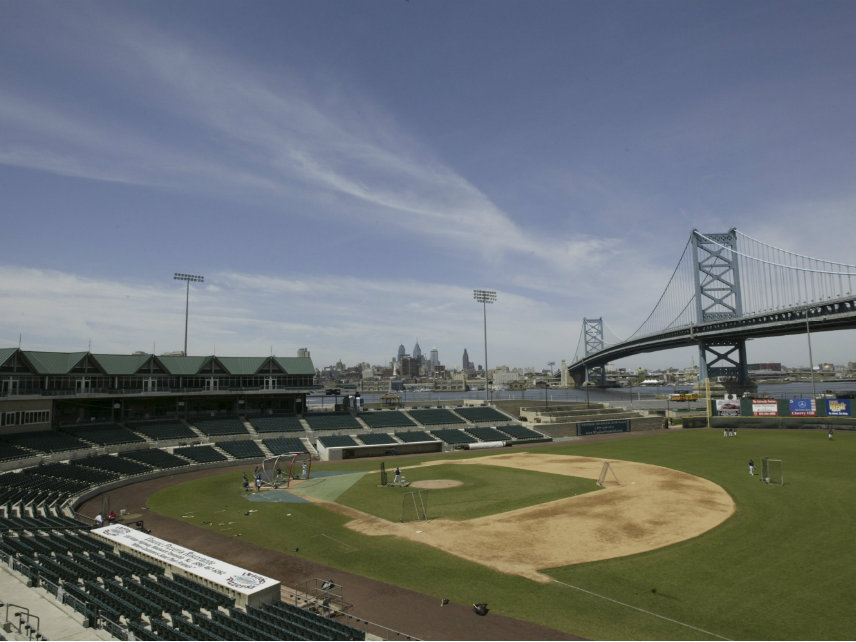Taxpayers Will Pay $1 Million to Tear Down $18 Million Baseball Stadium That Predictably Failed to Rejuvenate Camden
The stadium never turned a profit and the team skipped town when local officials decided to start charging rent.

Speaking in 2000 at the groundbreaking for a minor league baseball stadium in Camden, New Jersey, then-Governor Christine Todd Whitman reached for the most obvious cliche possible.
The state's economic development authorities, she said, had "heard the message from the movie, Field of Dreams: 'If you build it, they will come.'"
"Well, soon we will see a field of dreams right here in Camden, and my prediction is 'they will come,'" Whitman said.
Taxpayers spent more than $18 million to build the stadium that would eventually be named Campbell's Field, as part of a minor league ballpark-building frenzy across New Jersey that saw similar stadiums erected in Newark, Atlantic City, and Somerset—all part of redevelopment schemes that attracted independent minor league teams (that is, minor league teams not affiliated with the Major League Baseball farm system).
Less than two decades later, taxpayers in New Jersey will pay another $1 million to tear down Campbell's Field.
The sad saga of the Camden Riversharks—the Atlantic League team for whom the stadium was built prior to the 2001 season—will come to an official end more than three years after the team picked up and moved to New Britain, Connecticut, leaving Campbell's Field vacant. The city tried to attract a new team, but after those efforts failed, the Camden County Improvement Authority signed off on a plan to demolish the stadium, according to NJ.com. The Riversharks and Campbell's Field were supposed to revitalize the impoverished city by being the centerpiece of an economic development plan along the edge of the Delaware River. Now, the demolition of the stadium is the first step in a new $15 million economic development scheme that will turn the site into a complex of athletic fields for Rutgers University's Camden campus, NJ.com reports.
The stadium was a mistake from the start, though it did offer sweeping views of the Ben Franklin Bridge and the Philadelphia skyline across the river. The great view wasn't enough to convince fans to go to Camden, a deeply improverished city best known for its high crime rate. In the team's final two seasons, the Riversharks averaged about 3,000 fans per game—which is actually not bad by the standards of independent minor league baseball—but the team never turned a profit and abruptly skipped town in 2015 when negotiations on a new lease stalled.
By then, the ballpark was so deep in debt that it faced foreclosure because the team had missed several lease payments. To bail it out, Camden paid off $3.5 million in outstanding debt and purchased the property. The city planned to impose a new ticket surcharge to cover those costs, but the city only received one payment from the team before it moved away, NJ.com reported last year.
Camden's not the only city to dump a ton of money into a minor (or major) league ballpark under the guise of economic development, only to see the project become a fiscal black hole. The minor league teams that moved into Newark and Atlantic City around the same time as the Riversharks started playing in Camden have met similar fates. The Atlantic City Surf survived for 11 years before going bankrupt and the Newark Bears folded in 2014. Their riverfront stadium in downtown Newark is also set to be demolished less than 20 years after it was built.
"If there's a lesson here, it's that minor-league baseball stadiums are incredibly risky gambles," writes Neil deMause, author of the book Field of Schemes. "It's the rare team that brings in tons of fans after the initial honeymoon period and it's all too easy for a team to relocate or fold years before the stadium is paid off even if the team is helping to pay off the stadium debt, which it usually isn't."
Perhaps the only good news for taxpayers is that the Camden stadium didn't become an even bigger boondoggle—because it almost did.
Officials in Camden and Philadelphia had long dreamed of a cross-river cable car system—for reasons that really don't make any sense, considering the fact that cars, trains, and pedestrians can already use the Ben Franklin Bridge to get between the two places—and the baseball stadium nearly sparked that project into being. Philadelphia ended up spending $18 million on the tram system before abandoning the idea.
For all that money, all the city got was a large concrete arch along the riverfront.


Show Comments (29)